Several councils were held at Quierzy, a royal residence under the Carolingians, but now an insignificant village on the Oise in the French Department of Aisne in Picardy. The synod of September 838, [1] ordered the monks of the abbey of Saint-Calais in the Diocese of Le Mans to return to their monastery, from which they falsely claimed to have been expelled by their bishop. It also condemned some of the liturgical opinions of Amalarius of Metz.

A synod is a council of a church, usually convened to decide an issue of doctrine, administration or application. The word synod comes from the Greek σύνοδος (sýnodos) meaning "assembly" or "meeting", and it is synonymous with the Latin word concilium meaning "council". Originally, synods were meetings of bishops, and the word is still used in that sense in Catholicism, Oriental Orthodoxy and Eastern Orthodoxy. In modern usage, the word often refers to the governing body of a particular church, whether its members are meeting or not. It is also sometimes used to refer to a church that is governed by a synod.

Oise is a department in the north of France. It is named after the river Oise. Inhabitants of the department are called Oisiens or Isariens, after the Latin name for the river, Isara.

Aisne is a French department in the Hauts-de-France region of northern France. It is named after the river Aisne.
The two succeeding councils, held respectively in 849 and 853, dealt with Gottschalk and his peculiar teaching respecting predestination. The first of these meetings sentenced the recalcitrant monk to corporal castigation, deposition from the priestly office and imprisonment; his books were to be burned. At the second synod (853) the famous four decrees or chapters (capitula) drawn up by Hincmar on the predestination question were published. They asserted:
Hincmar, archbishop of Reims, was the friend, advisor and propagandist of Charles the Bald. He belonged to a noble family of northern Francia.

Predestination, in theology, is the doctrine that all events have been willed by God, usually with reference to the eventual fate of the individual soul. Explanations of predestination often seek to address the "paradox of free will", whereby God's omniscience seems incompatible with human free will. In this usage, predestination can be regarded as a form of religious determinism; and usually predeterminism.
- the predestination of some to salvation, and, in consequence of Divine foreknowledge, the doom of others to everlasting punishment;
- the remedy for the evil tendencies of free will through grace;
- the Divine intention of saving all men;
- the fact of universal redemption.
The council held in February 857 aimed at suppressing the disorders then so prevalent in the kingdom of Charles the Bald. The synod in 858 was attended by the bishops who remained loyal to Charles the Bald during the invasion of his dominions by Louis the German. [2] It addressed a firm but conciliatory letter to the invader stating its attitude towards him for the intentions which he expressed, but which his actions belied. Incidentally, it provides a terminus ante quem for the forgeries known as the False Decretals, which were quoted on the question of immunity for Church property. [3]

Charles the Bald was the King of West Francia (843–877), King of Italy (875–877) and Holy Roman Emperor. After a series of civil wars during the reign of his father, Louis the Pious, Charles succeeded by the Treaty of Verdun (843) in acquiring the western third of the Carolingian Empire. He was a grandson of Charlemagne and the youngest son of Louis the Pious by his second wife, Judith.
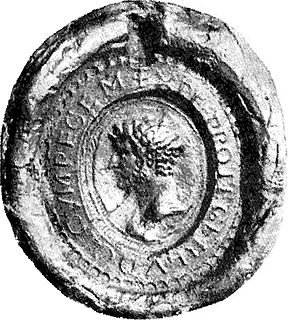
Louis "the German", also known as Louis II, was the first king of East Francia, and ruled from 843-876AD. Grandson of emperor Charlemagne and the third son of emperor of Francia, Louis the Pious and his first wife, Ermengarde of Hesbaye, he received the appellation Germanicus shortly after his death in recognition of Magna Germania of the Roman Empire, reflecting the Carolingian's assertions that they were the rightful descendants of the Roman Empire
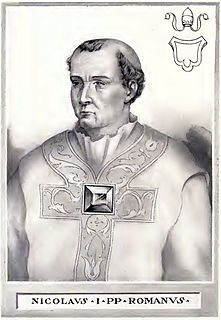
Year 858 (DCCCLVIII) was a common year starting on Saturday of the Julian calendar.
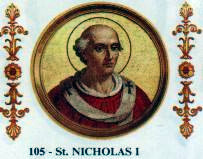
Pope Nicholas I, also called Saint Nicholas the Great, was Pope from 24 April 858 to his death in 867. He is remembered as a consolidator of papal authority and power, exerting decisive influence upon the historical development of the papacy and its position among the Christian nations of Western Europe. Nicholas I asserted that the pope should have suzerain authority over all Christians, even royalty, in matters of faith and morals.
Ratramnus a Frankish monk of the monastery of Corbie, near Amiens in northern France, was a Carolingian theologian known best for his writings on the Eucharist and predestination. His Eucharistic treatise, De corpore et sanguine Domini, was a counterpoint to his abbot Paschasius Radbertus’s realist Eucharistic theology. Ratramnus was also known for his defense of the monk Gottschalk, whose theology of double predestination was the center of much controversy in 9th-century France and Germany. In his own time, Ratramnus was perhaps best known for his Against the Objections of the Greeks who Slandered the Roman Church, a response to the Photian schism and defense of the filioque addition to the Niceno-Constantinopolitan Creed.

Febronianism was a powerful movement within the Roman Catholic Church in Germany, in the latter part of the 18th century, directed towards the nationalizing of Catholicism, the restriction of the power of the papacy in favor of that of the episcopate, and the reunion of the dissident churches with Catholic Christendom. It was thus, in its main tendencies, the equivalent of what in France is known as Gallicanism. Friedrich Lauchert describes Febronianism, in the Catholic Encyclopedia, as a politico-ecclesiastical system with an ostensible purpose to facilitate the reconciliation of the Protestant bodies with the Catholic Church by diminishing the power of the Holy See.
Gottschalk of Orbais was a Saxon theologian, monk and poet who is best known for being an early advocate of the doctrine of two-fold predestination. From his friend Walahfrid Strabo, Gottschalk also received the nickname Fulgentius, after Fulgentius the Mythographer, whom he may have studied intensively.
The Pseudo-Isidorian Decretals are a set of extensive, influential medieval forgeries written by a scholar known as Pseudo-Isidore. The forgers' main object was to emancipate bishops from the influence of archbishops, synods, and secular power by exalting papal supremacy.
The Capitulary of Quierzy, was a capitulary of the emperor Charles II, comprising a series of measures for safeguarding the administration of his realm during his second Italian expedition, as well as directions for his son Louis the Stammerer, who was entrusted with the government during his father's absence. It has traditionally been seen as the basis on which the major vassals of the kingdom of France such as the Counts of Flanders, were enabled to become more independent.

Ebbo or Ebo was archbishop of Rheims from 816 until 835 and again from 840 to 841. He was born a German serf on the royal demesne of Charlemagne. He was educated at his court and became the librarian and councillor of Louis the Pious, king of Aquitaine, son of Charlemagne. When Louis became emperor, he appointed Ebbo to the see of Rheims, then vacant after the death of Wulfaire.
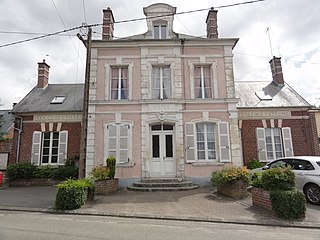
Quierzy is a commune in the Aisne department in Hauts-de-France in northern France, straddling the Oise River between Noyon and Chauny.
Lupus Servatus, also Servatus Lupus, in French Loup, was a Benedictine monk and Abbot of Ferrières Abbey during the Carolingian dynasty, who was also a member of Charles the Bald's court and a noted theological author of the 9th century. He is sometimes regarded as the first humanist of the Early Middle Ages because of the quality of his literary style, his love of learning, and his work as a scribe and textual critic.
Amalarius (c.775–c.850) was a Frankish prelate and courtier, temporary bishop of Trier (812–13) and Lyon (865–68) and an accomplished liturgist. He was close to Charlemagne and a partisan of his successor, Louis the Pious, throughout the latter's tumultuous reign.
Arles in the south of Roman Gaul hosted several councils or synods referred to as Concilium Arelatense in the history of the early Christian church.
Collections of ancient canons contain collected bodies of canon law that originated in various documents, such as papal and synodal decisions, and that can be designated by the generic term of canons.
Prudentius was bishop of Troyes, and a celebrated opponent of Hincmar of Reims in the controversy on predestination.
Remigius was archbishop of Lyon.
Hincmar, called the Younger, was the Bishop of Laon in the West Frankish Kingdom of Charles the Bald from 858 to 871. His career is remembered by a succession of quarrels with his monarch and his uncle, archbishop Hincmar of Rheims. After initial loyalty to Charles trouble occurred from 868 due to the allocation of benefices on the see's estates. The conflict grew dangerous as it became embroiled in the larger dispute of Lotharingian succession following Lothair II’s attempted divorce from his wife. Hincmar’s struggle against his king provides a Carolingian example of early Medieval clerical exemption.
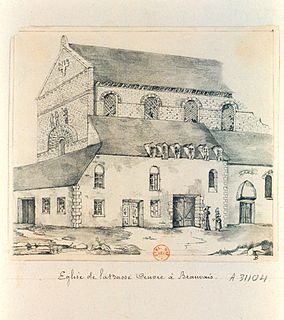
Odo I was a West Frankish prelate who served as abbot of Corbie in the 850s and as bishop of Beauvais from around 860 until his death in 881. He was a courtier and a diplomat, going on missions to East Francia and the Holy See.
Amulo Lugdunensis served as Archbishop of Lyons from 841 to 852 AD. As a Gallic prelate, Amulo is best known for his letters concerning two major themes: Christian-Jewish relations in the Frankish kingdom and the Carolingian controversy over predestination. He was ordained as archbishop in January 841.

The Collectiones canonum Dionysianae are the several collections of ancient canons prepared by the Scythian monk Dionysius 'the humble' (exiguus). They include the Collectio conciliorum Dionysiana I, the Collectio conciliorum Dionysiana II, and the Collectio decretalium Dionysiana. They are of the utmost importance for the development of the canon law tradition in the West.













